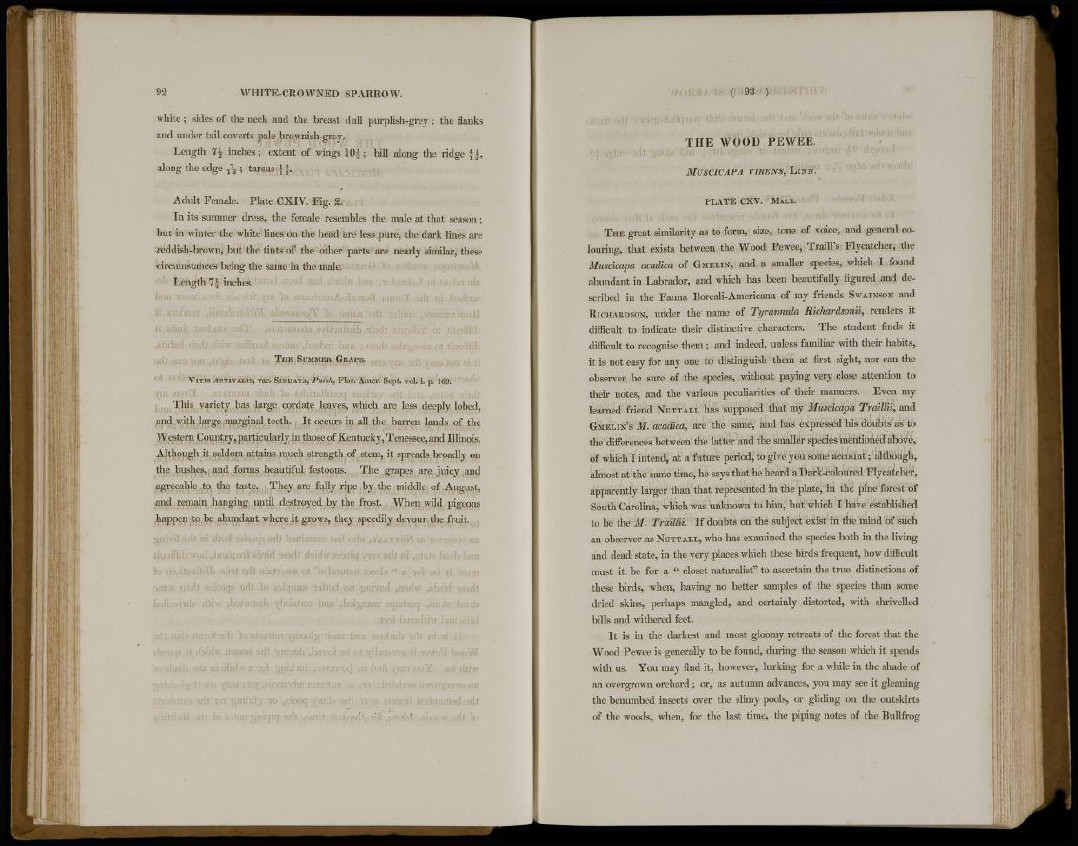
92 W H I T E - C R O W N E D S P A R R O W .
white; sides of the neck and the breast dull purplish-grey ; the flanks
and under tail-coverts pale brownish-grey.-
Length 7^ inches; extent of wings 1 0 | ; bill along the ridge }(,
along the edge T
7
g ; tarsus \ |,
Adult Female. Plate CXIV. Fig. 2.
In its summer dress, the female resembles the male at that season ;
but in winter the white lines on the head are less pure, the dark lines are
-reddish-brown, but the tints of the other parts are nearly similar, these
circumstances being the same in the male.
Length 7£ inches.
T H E S U M M E R G R A P E.
V I T I S V E S T I V A L I S , var. S I N U A T A , Pursh, Flor. Amer. Sept. vol. i. p. 1G9.
This variety has large cordate leaves, which are less deeply lobed,
and with large marginal teeth. It occurs in all the barren lands of the
Western Country,particularly in those of Kentucky, Tenessee,and Illinois.
Although it seldom attains much strength of stem, it spreads broadly on
the bushes, and forms beautiful festoons. The grapes are juicy and
agreeable to the taste. They are fully ripe by the middle of August,
and remain hanging until destroyed by the frost. When wild pigeons
happen to be abundant where it grows, they speedily devour the fruit.
•
( 93 )
T H E W O O D P E W E E.
MUSCÍCAPA VIRENS, LINN.
P L A T E CXV. MALE.
T H E great similarity as to form, size, tone of voice, and general colouring,
that exists between the Wood Pewee, Traill's Flycatcher, the
Muscícapa acadica of GMELIN, and a smaller species, which I found
abundant in Labrador, and which has been beautifully figured and described
in the Fauna Boreali-Americana of my friends SWAINSON and
RICHARDSON, under the name of Tyrannida Richardso?iii, renders it
difficult to indicate their distinctive characters. The student finds it
difficult to recognise them ; and indeed, unless familiar with their habits,
it is not easy for any one to distinguish them at first sight, nor can the
observer be sure of the species, without paying very close attention to
their notes, and the various peculiarities of their manners. Even my
learned friend NUTTALL has supposed that my Muscícapa Traittii, and
GMELIN'S M. acadica, are the same, and has expressed his doubts as to
the differences between the latter and the smaller species mentioned above,
of which I intend, at a future period, to give you some account; although,
almost at the same time, he says that he heard a Dark-coloured Flycatcher,
apparently larger than that represented in the plate, in the pine forest of
South Carolina, which was unknown to him, but which I have established
to be the M. Traittii. If doubts on the subject exist in the mind of such
an observer as NUTTALL, who has examined the species both in the living
and dead state, in the very places which these birds frequent, how difficult
must it be for a closet naturalist" to ascertain the true distinctions of
these birds, when, having no better samples of the species than some
dried skins, perhaps mangled, and certainly distorted, with shrivelled
bills and withered feet.
It is in the darkest and most gloomy retreats of the forest that the
Wood Pewee is generally to be found, during the season which it spends
with us. You may find it, however, lurking for a while in the shade of
an overgrown orchard; or, as autumn advances, you may see it gleaning
the benumbed insects over the slimy pools, or gliding on the outskirts
of the woods, when, for the last time, the piping notes of the Bullfrog